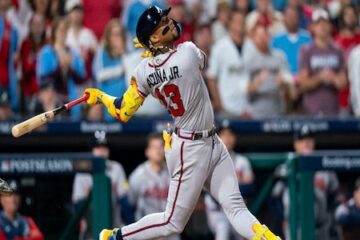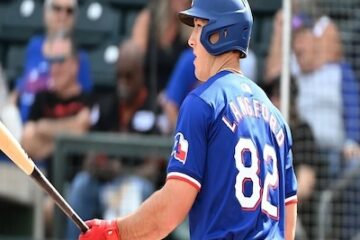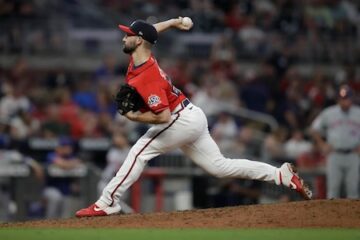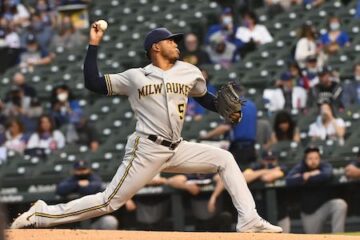2017 Fantasy Baseball: Monitoring Outfielder Trends
Late in the draft, you would have been looking for specific stats to round off your team. That’s what you do. It’s the 20th round and you’re light on speed. So you draft Rajai Davis, knowing he has next to zero power and will likely only knock in a couple of runs a week. But he has the speed you need.
You still need some power, so in round 21 you take a chance and pick Aaron Judge. (Hey, how’s that working out for ya?).
That’s how drafts go. Your later picks should be guys who fill needs and holes your earlier picks have left. Predominately, these will be in the outfield spots. That’s mainly because outfielders are easier to come by during drafts and in season. There’s more versatility with outfielders too.
Not many first basemen will get double digit steals. Certainly none who get drafted outside the top 150. How many middle infielders would you be able to draft in the last 7 or 8 rounds who can hit 20 homers? You could count them on one hand.
That’s not even taking into consideration that more infielders get outfield eligibility during the season than the other way around. So it’s in your outfield where you will be able to fill in gaps during the draft and once the season gets going.
So what do you do when 4 weeks into the season, some of those outfielders you drafted solely for the purpose of a category boost aren’t contributing how you needed them to?
Well, I’ve picked out 3 outfielders who were drafted with a specific requirement in mind, but have yet to fulfil that particular role. And, what to do with them.
Manny Margot
Margot was drafted as a speedster. Depending on which projections you viewed, 30 stolen bases were seen as an average expectation over the course of 2017.
Since making his debut in the Red Sox farm system in 2012, Margot has made a name for himself on the bases. Each stop off at the minor league levels, Margot has always stolen bases.
2012 – 33 (68 games at Rookie Ball)
2013 – 18 (49 games at Low A)
2014 – 42 (115 games at A and High A)
2015 – 39 (110 games at High A and Double A)
2016 – 32 (134 games at Triple A and MLB)
That’s not including what he’s done at Foreign Winter Leagues.
But so far this year, Margot has managed just 4 steals, on pace for 24 over 162 games. So realistically, just topping 20 is about where he’s at right now. A far cry from the 30+ we were hoping for.
So why is that? Well the big issue with Margot is he’s only successful on 50% of stolen base attempts for far. Joey Gallo, Freddie Freeman and Chase Headley have all matched Margot’s 4 steals this year, without being caught 4 times.
This has been a bit of an issue for Margot throughout the minors. The 162 Minor League stolen bases came from 217 attempts. That’s a success rate of just under 75%. That’s pretty much what you’d expect from a decent base stealer at the Major League level. But a disappointment for someone who’s biggest asset was their speed.
So his early going of 50% isn’t going to cut it. The speed is there. The opportunities are there. But Margot needs to learn that Major League pitchers and catchers aren’t Minor League pitchers catchers. Raw speed alone isn’t going to cut it.
At 22 and with less than 40 Major League games under his belt, Margot still has plenty of time to develop his reads, improve his jumps and learn that stealing bases isn’t just about speed.
George Springer for example stole just 9 bases from 19 attempts last year and is 0 for 2 this year. His minor league stolen base success rate was 84%, compared to his MLB rate of just 62.5%.
So what about Margot going forward? Well, you have to hope the green light remains and he does figure things out on the bases. There’s no reason to suggest it won’t. Even if his success rate doesn’t creep up much beyond 50%, he still holds value for 2017.
Margot is entrenched atop the Padres batting order. Granted, the Padres aren’t going to score a load of runs, but batting lead-off for any team will present enough chances to score runs and be valuable for fantasy teams. Accounting for 15 of the 108 runs the Padres have scored to date actually has Margot ranked 22nd among outfielders.
Margot has hit 3 homers already and is also hitting .261 which isn’t going to win him any batting crowns; it’s also not going to hurt your fantasy team either. After all, .260 is the new .300.
So providing Margot continues to bat lead-off and attempt to steal bases, he will still be a valuable asset in any league. Only owned in 50% of ESPN leagues right now, Margot should be picked up if you are chasing speed or runs. In fact, there’s a very good case that he’s a nice buy low option for team’s chasing steals. If he figures things out soon, 30+ steals is very achievable by season’s end.
The Cubs raised some eyebrows this offseason when they announced Schwarber as their everyday lead-off man. The reasoning wasn’t because they expected him to turn into the next Billy Hamilton on the bases, but because he was able to get on base.
And the truth is; Schwarber has managed to do that. Whilst his average currently sits below the Mendoza Line, his OBP is a pretty decent .317 which is higher than the aforementioned Margot’s (.293).
In fact, Schwarber’s OBP compares favourably among outfielders who have notably batted lead-off this year;
Steven Souza .393 (only leads off vs LHP)
Kevin Pillar .345
Brett Gardner .330
Kyle Schwarber .317
George Springer .305
Dexter Fowler .298
Ender Inciarte .296
Manny Margot .293
Billy Hamilton .268
Rajai Davis .262
Providing he still gets on base as he has been doing, the Cubs don’t seem like they’ll be moving him from top spot in the lineup.
Without playing in leagues which count OBP, Schwarber’s batting average will be doing you some harm. But given who hits behind him for the Cubs, he will still score plenty of runs. He currently has 14 and four of those have come from homers. Although, that’s only on pace for around 80 runs and the likelihood is you was looking at him reaching triple digits.
Considering he hasn’t stolen a base so needs help getting into scoring position when he does walk, 14 runs is pretty good going. Schwarber wasn’t projected to hit for much of an average anyways. Anywhere between a .230 to .260 batting average was projected. So in all likelihood, you didn’t draft him for anything over than runs and homers.
And right now, that’s what he’s giving you. His .254 BABIP suggests his average will climb up to expected levels and that will only lead to more runs. It’s important to remember that this is still a young hitter too, someone who has yet to play 100 Major League games. So there’s still a learning curve.
And like Manny Margot, once he gets more things figured out, the results could come quickly. If you’re in need of runs and can take a bit of a batting average hit, Schwarber is someone who’s fantasy value probably sits as low as it will be all season. There will never be a better time to trade for Schwarber.
Granderson is another guy who was drafted in later rounds, in the hope he’ll hit 25+ homers. Unlike Margot and Schwarber, Granderson is at the end of his career. Now 36, he’s starting to play like someone near the end of his career.
In 2016, Granderson was the Mets’ main lead-off hitter. His .364 OBP the year before and the fact there was still plenty of life left in the legs made this seem like a good idea. He managed to steal 11 bases in 2015 too.
Granderson then went and hit 30 homers, something he’d only achieved once outside of the Bronx.
Nothing else improved however. His OBP was down to .335 which is still solid for a lead-off hitter. His average also took a dip from .259 to .237 and he managed just 4 stolen bases. Decline was taking place.
This year, Granderson started the Mets’ season as their clean-up hitter. So the runs he’d accrue batting lead-off would diminish. But he’s now got more RBI opportunities, so that’s a pretty decent trade off. As fantasy owners, we could stomach that.
As of now however, Granderson is not even a locked-in everyday player. This is despite Cespedes being on the DL.
Granderson’s average sits at a measly .122 with a .175 OBP. Even his slugging percentage is a pathetic .211. With just one homer to show for his efforts too, Granderson is a major flop in 2017. He has just one hit since April 22nd (going 1 for 30 in that span).
Compared to 2016, his line drive rate is down 10%, fly ball rate is up 14% and infield fly ball rate is a staggering 21% (up from 4.5%). As a consequence, his HR/FB is just 2.6%. You can also look at his BABIP and say he’s been unlucky.
Those numbers are not sustainable. But they also make more sense when you look at the sort of contact he’s making.
The major concern is his soft contact rate sitting at 28% (up 12% on last year) and his hard contact rate at a measly 25% (down 12% on 2016). So in simple terms, he’s hitting the ball soft more than he’s hitting it hard.
Now all those pop-ups and lack of home runs make sense.
I do expect Granderson’s average to head north and see some more homers. But at 36 years old, on a team struggling to stay healthy and stay in touch atop the NL East, Granderson is someone I’m dropping in pretty much any format.
As the Mets fall further out of playoff contention, Granderson is likely a guy the Mets will move on from. Something you should be doing too.
So that’s some outfield food for thought. This weekend we will have your usual weekly preview so come back for that. And follow The Fantasy Fix on Twitter for all the latest news and articles, as well as me for any questions or advice you seek.
So until the weekend, happy fantasying.





